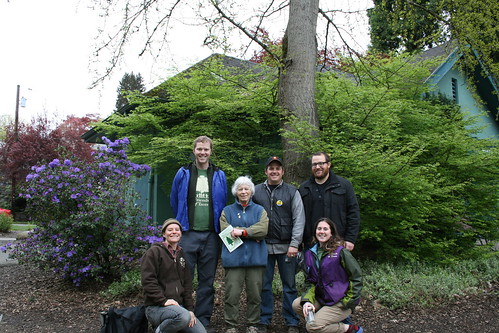A tree walk through history in Laurelhurst Park

By Andy Meeks
On Wednesday morning approximately 30 people were treated to a walking tour highlighting the trees and history of Laurelhurst Park.
Phyllis Reynolds, author of “Trees of Greater Portland” and longtime Friends of Trees supporter, led the tour as part of the Portland Parks & Recreation’s (PP&R) Arbor Week.
Reynolds has done extensive research and mapping work in the Southeast Portland park and said that there are nearly 1,000 trees in the park consisting of almost 115 species, about one-third of which are Douglas-firs. She gave a very thorough, descriptive and entertaining walk past ginkgos, grand firs, the Concert Grove lindens, black oaks, sycamore maples, giant sequoias, Kentucky coffeetrees, white oaks and dawn redwoods.
The group learned from Reynolds that Laurelhurst Park was once part of the 462-acre Hazel Fern Farm owned by William Sargent Ladd, a native of Vermont who twice served as Portland’s mayor in the 1850s. He used it as a dairy farm and also raised Clydesdale draft horses and cattle. Ladd died in 1893 and his heirs sold the surrounding land to a group of developers who created the Laurelhurst neighborhood in conjunction with Frederick Law Olmsted’s landscape architecture firm.
Ladd’s heirs also sold a 31-acre parcel to the city of Portland that became Ladd Park (later renamed Laurelhurst Park). Olmsted’s firm sent Emanuel Tillman Mische to Portland to work on this development and in 1908 he become Portland’s Superintendent of Parks, said Reynolds.
Mische designed Laurelhurst Park guided by the principal, according to Reynolds, that “parks don’t become beautiful overnight.” Mische wanted the park to be a natural park in the mold of Central Park and he left about 100 conifers in place, most of which are Douglas-firs and are still growing. Additionally, he planted about 265 trees that still remain.
Reynolds also explained the unique nature of the dawn redwood—a deciduous conifer related to the bald cypress tree. A native of China, the dawn redwood is also Oregon’s State Fossil. Thought to be extinct, seeds and cones of the dawn redwood were brought to the United States from China by Harvard researchers in the 1940s and distributed to various arboreta around the country.
Hoyt Arboretum received some of these seeds and successfully grew dawn redwoods—which still live in Hoyt Arboretum today. According to Reynolds, these trees were the first dawn redwoods to bear cones in the Western Hemisphere in 16 million years. There are five dawn redwoods in Laurelhurst Park today.
Meeks is the volunteer and outreach specialist at Friends of Trees: 503-282-8846 ext. 24, [email protected]
